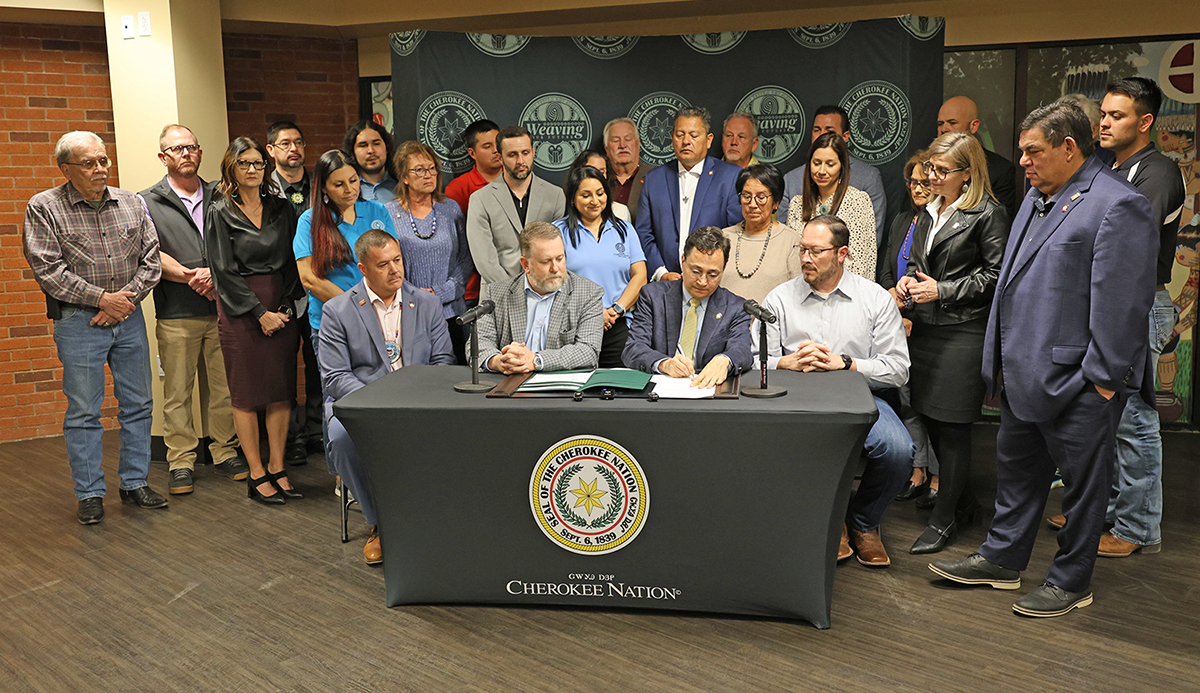
- Details
- By Chuck Hoskin Jr
Guest Opinion. At the Cherokee Nation, we have long been committed to building a health system that is among the best in the world. What sets our mission apart is not just the scale of the services, but also a commitment to research and transparency. By commissioning comprehensive health care studies, publishing those findings and using the results to guide policy, the Nation elevates health outcomes for our people while setting a health care model for Indian Country and beyond.
The latest set of public reports reinforces our approach. By examining telemedicine, dialysis care and Medicare coverage, the Nation has taken a hard look at how Cherokee Nation Health Services serves patients and where improvements may be made. These studies do not shy away from exploring solutions to tough challenges. They provide a roadmap for the future, showing areas for strategic investment and paths to deliver lasting change.
In telemedicine, research shows that virtual care has become indispensable, particularly for Cherokee Nation’s behavioral health offerings. We have seen rapid growth in behavioral health as stigmas wane and positive results rebuild healthy families. Telemedicine also eases many of the staffing issues we see nationally. However, barriers remain, such as reliable broadband access in rural northeast Oklahoma communities and shifting federal regulations for medical practice across state lines. Our study highlights a need for stronger infrastructure and expanded partnerships to increase telehealth access.

Our dialysis report provides clarity about the realities of offering outpatient services within the Cherokee Nation Reservation. Operating a full clinic may not yet be feasible, because many of our citizens live in rural communities across the Reservation and would experience long travel times. The research instead highlights other strategies, including increased collaboration with existing providers, utilizing home-based options, and connecting our wellness and diabetes programs to partner on prevention. These solutions represent progress built on evidence.
The Medicare study underscores the importance of both patient access and financial sustainability. The report outlines a strategy we can follow to help close these gaps. That also includes expanding prescription drug coverage and preparing for a pilot program to sponsor increased coverage in 2026. This forward-looking plan can strengthen the entire Cherokee Nation Health Services system.
Taken collectively, these isolated studies reflect a deliberate larger strategy: to collect information, identify places for improvement and share the findings publicly to guide our decisions. This process will not only create smarter policy for the future, but it builds confidence among Cherokees that their health system is evolving with a true purpose of service.
We are not standing still. This is how world-class health care is built — step by step, report by report, and always guided by the needs of our people.
Chuck Hoskin, Jr. is the principal chief of the Cherokee Nation.
More Stories Like This
Uranium: Boom Time for Uranium, the Good, Bad and DirtyThe Federal Budget Must Contain Advance Appropriations for Native Health
The University and Free Speech
Delivering a Wellness Dividend
Help us tell the stories that could save Native languages and food traditions
At a critical moment for Indian Country, Native News Online is embarking on our most ambitious reporting project yet: "Cultivating Culture," a three-year investigation into two forces shaping Native community survival—food sovereignty and language revitalization.
The devastating impact of COVID-19 accelerated the loss of Native elders and with them, irreplaceable cultural knowledge. Yet across tribal communities, innovative leaders are fighting back, reclaiming traditional food systems and breathing new life into Native languages. These aren't just cultural preservation efforts—they're powerful pathways to community health, healing, and resilience.
Our dedicated reporting team will spend three years documenting these stories through on-the-ground reporting in 18 tribal communities, producing over 200 in-depth stories, 18 podcast episodes, and multimedia content that amplifies Indigenous voices. We'll show policymakers, funders, and allies how cultural restoration directly impacts physical and mental wellness while celebrating successful models of sovereignty and self-determination.
This isn't corporate media parachuting into Indian Country for a quick story. This is sustained, relationship-based journalism by Native reporters who understand these communities. It's "Warrior Journalism"—fearless reporting that serves the 5.5 million readers who depend on us for news that mainstream media often ignores.
We need your help right now. While we've secured partial funding, we're still $450,000 short of our three-year budget. Our immediate goal is $25,000 this month to keep this critical work moving forward—funding reporter salaries, travel to remote communities, photography, and the deep reporting these stories deserve.
Every dollar directly supports Indigenous journalists telling Indigenous stories. Whether it's $5 or $50, your contribution ensures these vital narratives of resilience, innovation, and hope don't disappear into silence.
 The stakes couldn't be higher. Native languages are being lost at an alarming rate. Food insecurity plagues many tribal communities. But solutions are emerging, and these stories need to be told.
The stakes couldn't be higher. Native languages are being lost at an alarming rate. Food insecurity plagues many tribal communities. But solutions are emerging, and these stories need to be told.
Support independent Native journalism. Fund the stories that matter.
Levi Rickert (Potawatomi), Editor & Publisher
